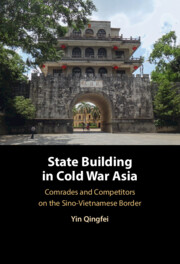Book contents
- Frontmatter
- Contents
- Figures
- Maps
- Acknowledgments
- Notes on Romanization, Names, and Pseudonymization
- Abbreviations
- Introduction
- 1 Asymmetric State Building (1949–1954)
- 2 Joint State Building (1954–1957)
- 3 Negotiated State Building (1958–1964)
- 4 Thwarted State Building on the Sea (1954–1964)
- 5 Reversed State Building (1965–1975)
- Conclusion
- Bibliography
- Index
3 - Negotiated State Building (1958–1964)
Published online by Cambridge University Press: 18 December 2024
- Frontmatter
- Contents
- Figures
- Maps
- Acknowledgments
- Notes on Romanization, Names, and Pseudonymization
- Abbreviations
- Introduction
- 1 Asymmetric State Building (1949–1954)
- 2 Joint State Building (1954–1957)
- 3 Negotiated State Building (1958–1964)
- 4 Thwarted State Building on the Sea (1954–1964)
- 5 Reversed State Building (1965–1975)
- Conclusion
- Bibliography
- Index
Summary
This chapter examines how borderlands state building backfired against the background of aggressive collectivization movements in the two counries from 1958 to 1964. During agricultural collectivization, state building by the two communist states at the border became increasingly coercive. The border people nevertheless sought to take advantage of the porous international boundary to resist state incursion by voting with their feet, making the extension of state authority and its functions a highly contested process. The years from 1958 to the escalation of the Vietnam War in 1964 witnessed a widening gap between what the two centralizing governments sought to achieve at their shared border and the capabilities of the state organs stationed on the ground to pursue the diplomatic and state-building tasks assigned to them by the political centers. The famine caused by the Great Leap Forward drove an increasing number of unauthorized border crossings. The Vietnamese communists, who initiated their own cooperative movement in 1958, perceived the emerging chaos in China as detrimental to the consolidation of the DRV state. This severely tested the ability of the Chinese and Vietnamese local officials to enforce their recently established border control institutions, making this a prominent bilateral issue.
Keywords
- Type
- Chapter
- Information
- State Building in Cold War AsiaComrades and Competitors on the Sino-Vietnamese Border, pp. 118 - 156Publisher: Cambridge University PressPrint publication year: 2024

